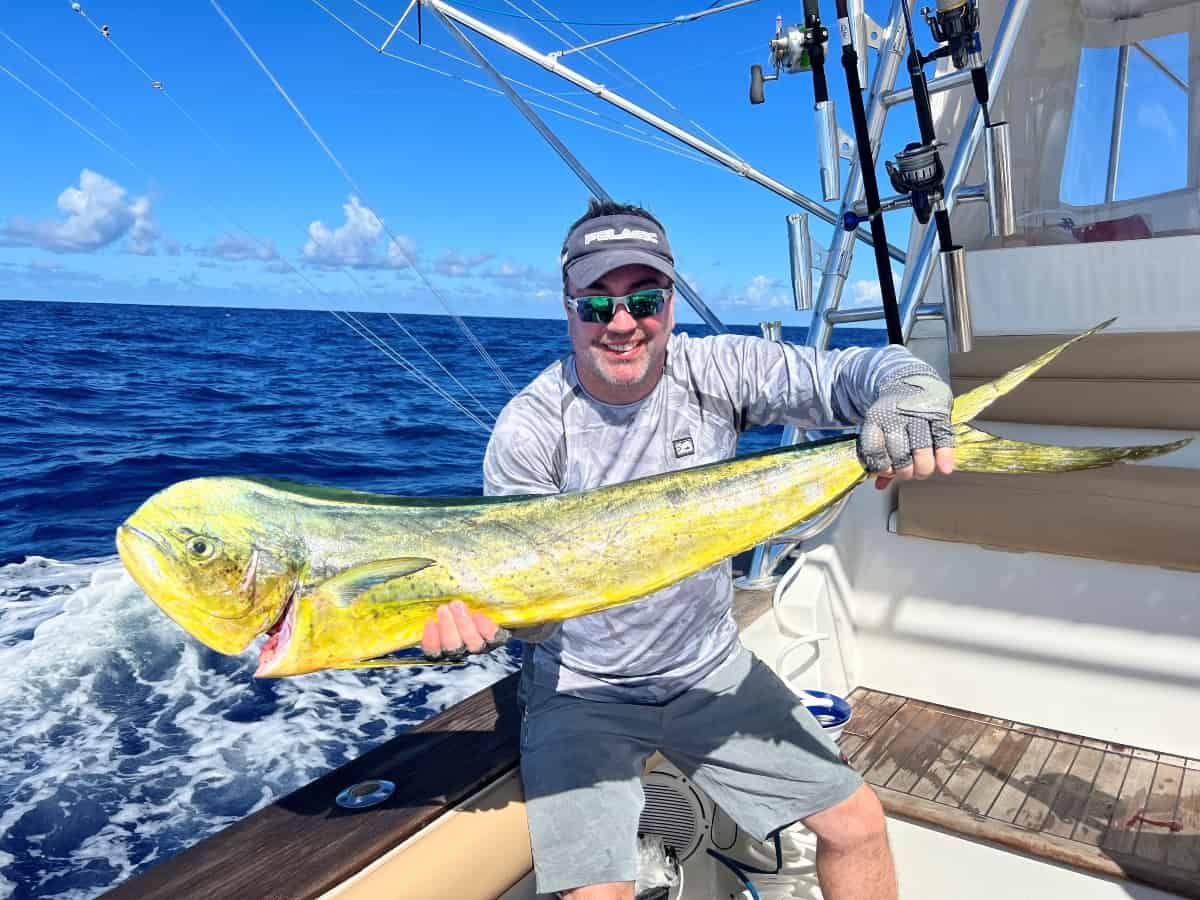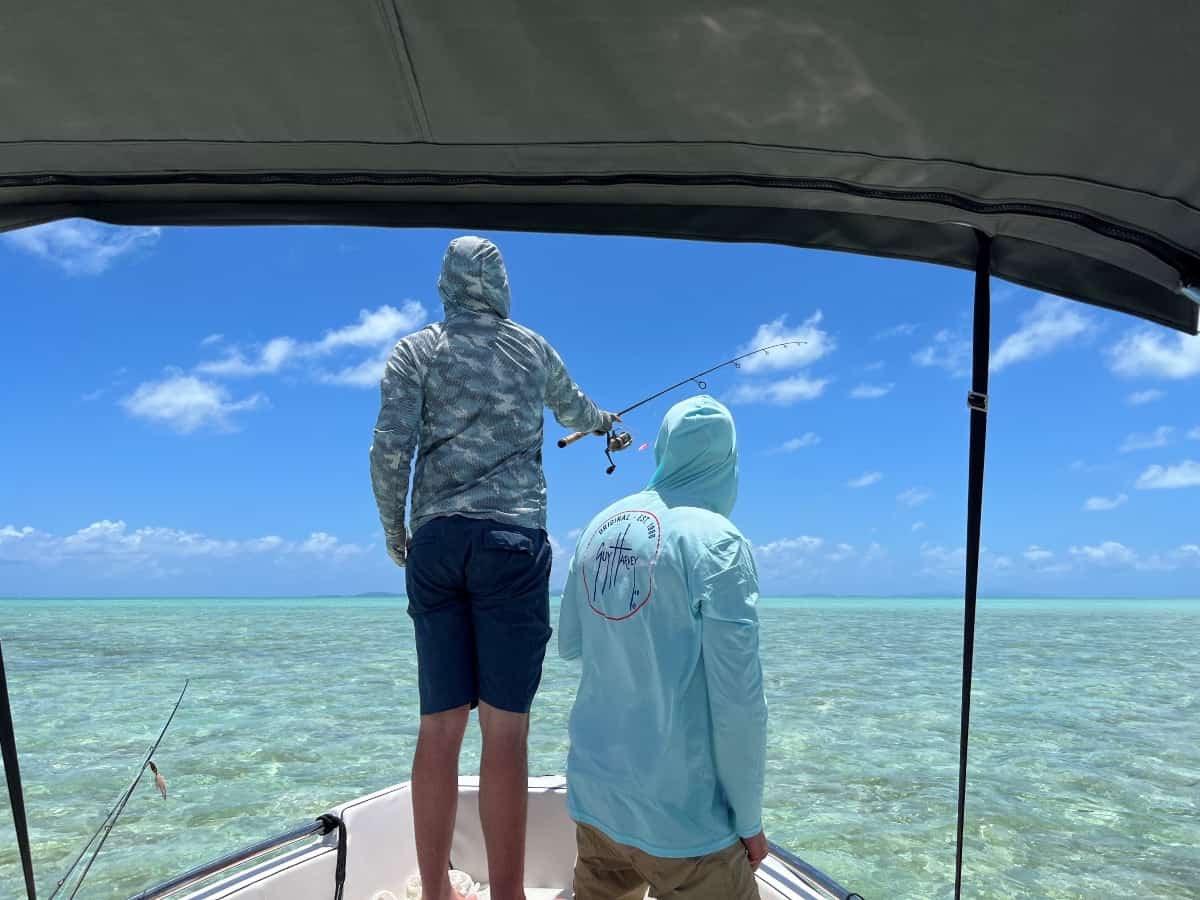From catching snapper off the shoreline to flyfishing for bonefish, trolling for Atlantic blue marlin, and everything in between, The British Virgin Island waters are a fishing paradise.
The BVI has an excellent fisheries department who are dedicated to conservation and protecting the fishery, and they have many important rules and regulations you must follow. They can also help you get a fishing license, so make sure you speak with them.

One thing to note about fishing in the British Virgin Islands is that not all fish are edible, so you need to make sure you know what you catch and eat. Some fish contain the toxin ciguatera, which is produced by tiny algae that grow around coral reefs.
Ciguatera fish poisoning can be life-changing. I ate a contaminated horse-eye jack, and I’m still experiencing problems, such as supercharged intolerances and a reduced ability to see the contrast in colours. That is why I am going to split every fish I discuss here into one of two categories: game fish and fish for the grill.
Before we start, I want to leave you with one piece of advice: if you aren’t sure if a fish is safe to be eaten, don’t eat it. I can assure you from experience that it’s not worth the risk.
Where Can You Sportfish in the BVI?
There are three main areas in the BVI where you can fish: the North Drop, the South Drop, and the horseshoe reef. There is also the Seamount in the south, but it’s a long way and a difficult place to fish unless you’re a local. You can read our BVI sailing guide to learn how to get around the islands.
If you are new to the British Virgin Islands and fishing for the grill, I recommend starting with the North. Fish caught there are generally safer to eat than those in the South. Although the horseshoe reef is brilliant for game fishing unless you are very familiar with the area. My advice is don’t eat anything other than Tuna, Wahoo, and Mahi Mahi.
What Can You Fish in the BVI?
Almost anything that you could want to fish is available in these Caribbean waters. That’s why it is my favourite place to fish in the world.

Let’s start with all the options for game fishing. For Atlantic blue marlin, I recommend going in June when they are the biggest or during the August full moon if you are looking for quantity. There are also white marlin and sailfish.
If you are a fly fisher, you can catch bonefish, tarpons, permits, and various jacks, such as the bar jack and hardnose jack. The bone fishing off Anegada is fantastic, and there are a couple of local guides who will get you on the fish. Kevin Faulkner is my favourite guide because he is also a conservationist, but all the guides are great.
Reach out to the Anegada reef hotel for more advice. If you get a chance to speak to Bozo, he is always around the hotel, and he knows more about fishing than almost anyone else here.
But one of the most common fish to catch in the British Virgin Islands is the barracuda, which are really wicked fish. Be warned that you should never eat barracuda from any location, even if a local tells you it’s okay. They may have developed a tolerance to toxins, but if you do not live there, do not eat barracuda.
Despite this, barracuda are so much fun to catch. You will need a wire trace, and you can also catch them with lures, live bait, and I have personally caught lots on flies. Try small silver spoons too, since the takes are awesome.
Now, let’s move on to fishing for the grill. The pelagic fish are the best place to start because they are always safe to eat. The BVI has a world-class wahoo fishery, meaning you can catch wahoo year-round, although the key months are November through May. Also in the pelagic category are the mahi mahi, yellowfin tuna, skipjack tuna, bigeye, and Atlantic bonito.
Fishing Methods In The BVI
There are three main methods that I use for fishing: trolling, live baiting, and jigging.
Trolling
Trolling is a great method if you are fishing for the pelagics, although any method can work.
When trolling, I recommend fishing at a depth between 284 to 494 feet because that’s where you will find the greatest concentration of the pelagic species. It’s also the BVI phone numbers, so it’s easy to remember.
The most successful method I have found for trolling is zig-zagging over the drop-off lines on your GPS because that is where the fish congregate, using skirted ballyhoo and lures. For all three fishing areas in the BVI, the top colours for the lures are black and red, blue and pink, and green and black.
If you’re trolling, run between 6 and 9 knots. The setup we use is running 5 lines. Two of the lines are flat with 24 oz leads and a 300lb shock leader onto a wire leader. 9/0 game hooks are my choice. On our flats, we run a black and red skirted ballyhoo on the port and a black and green on the starboard. On the long riggers, we run blue and pink on port and green and yellow on starboard. On the 5thline, we run small jet heads, feathers, or something similar for tuna.
If you are meat fishing in 400-600ft of water, and you don’t want to catch a marlin, do not put out a blue and white islander with ballyhoo. You will get a marlin, and you cannot eat them!
Live Bait
A cast-net or sabiki (a set of small bait fish lures) is used for catching tiny bait fish that are kept in a livewell or a bucket with an aerator until you reach your fishing location. There is normally an abundance of sprats and goggle eyes around the piers, marinas, and most of the bays.
Live bait fishing is a great way to target large predatory fish. The best way to catch yellow-fin tuna in the BVI is with live sprat as bait. Live baiting can be extremely productive in areas where there is a rapid depth change or current lines, particularly if there are sea birds feeding or bait schools showing on your sounder.
We have caught multiple 100lb yellowfin tuna. Our record day is 28 yellowfin averaging 60 lbs each. My advice is to live bait in 600ft of water and drift while throwing small numbers of bait. Deep sea fishing is great in the British Virgin Islands.
Jigging
Over the last few years, we have had a lot of success jigging in 300 to 600 feet on the drop-offs and caught lots of tuna and wahoo. Jigs come in a whole range of different shapes and sizes. If you’re targeting deeper waters, use the heavier fast fall jigs that are 100–250 grams to ensure you can work the whole water column. If you’re targeting shallow waters around the reef, I find that using flat fall or flutter jigs, between 60–80 grams, is really effective.
What Equipment Do You Need to Fish in the BVI?

The BVI has really big fish, which means you need big equipment. The average size Wahoo is 30 to 60 pounds. Mahi mahi ranges between 10 and 30 pounds. Tuna starts at 10 pounds and go up to a whopping 130 pounds.
If you just want to have fun and catch some fish, bring a 30lb spinning tackle set up. Also, bring a selection of jigs, lures, bucktails, some varying hooks, and leaders. You can catch tarpon off a sailboat at night, yellowtail snapper off the rocks, bonefish on the flats, and you can even troll with spinning tackle and pick up kingfish, bonito, and the prodigious hardnose. When I first arrived in the BVI, I was learning to fish the different areas, and it was such an amazing journey.
When I first fished in the BVI, I wanted to fish light tackle and ended up losing a lot of gear because they broke the line off. To avoid any expensive mistakes, I recommend buying a 50-pound class trolling gear with an 80-pound line and a 300-pound shock leader onto a wire leader.
I’m going to finish off with an important note. Fishing is highly regulated, so anyone who wants to fish must get a BVI fishing license first. Short-term visitors can obtain 30-day pleasure fishing permit from the Department of Fisheries and Agriculture branch of the BVI Government. I can assure you that the joy of fishing in the BVI is well worth the process of getting a license.
